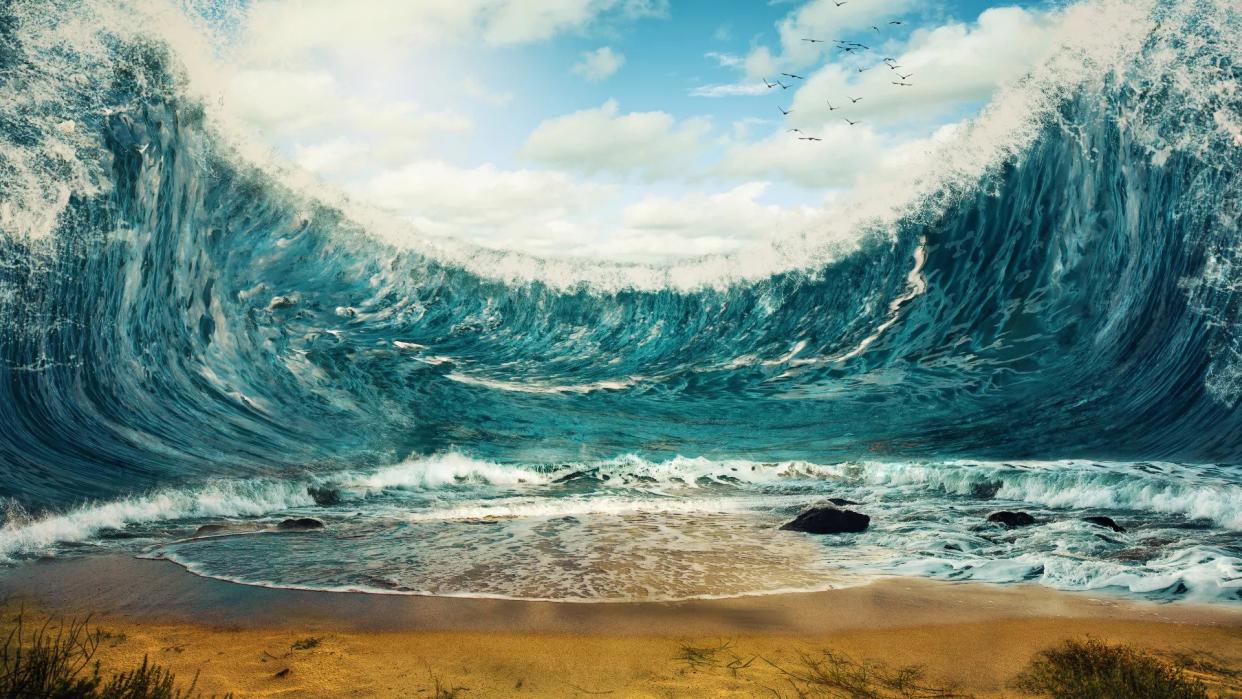Climate change could trigger gigantic deadly tsunamis from Antarctica, new study warns

Climate change could unleash gigantic tsunamis in the Southern Ocean by triggering underwater landslides in Antarctica, a new study warns.
By drilling into sediment cores hundreds of feet beneath the seafloor in Antarctica, scientists discovered that during previous periods of global warming — 3 million and 15 million years ago — loose sediment layers formed and slipped to send massive tsunami waves racing to the shores of South America, New Zealand and Southeast Asia.
And as climate change heats the oceans, the researchers think there's a possibility these tsunamis could be unleashed once more. Their findings were published May 18 in the journal Nature Communications.
Related: Widening chasm births Antarctic iceberg larger than Los Angeles
"Submarine landslides are a major geohazard with the potential to trigger tsunamis that can lead to huge loss of life," Jenny Gales, a lecturer in hydrography and ocean exploration at the University of Plymouth in the U.K., said in a statement. "Our findings highlight how we urgently need to enhance our understanding of how global climate change might influence the stability of these regions and potential for future tsunamis."
Researchers first found evidence of ancient landslides off Antarctica in 2017 in the eastern Ross Sea. Trapped underneath these landslides are layers of weak sediment crammed with fossilized sea creatures known as phytoplankton.
Scientists returned to the area in 2018 and drilled deep into the seafloor to extract sediment cores — long, thin cylinders of the Earth’s crust that show, layer by layer, the geological history of the region.
By analyzing the sediment cores, the scientists learned that the layers of weak sediment formed during two periods, one around 3 million years ago in the mid-Pliocene warm period, and the other roughly 15 million years ago during the Miocene climate optimum. During these epochs, the waters around Antarctica were 5.4 degrees Fahrenheit (3 degrees Celsius) warmer than today, leading to bursts of algal blooms that, after they had died, filled the seafloor below with a rich and slippery sediment — making the region prone to landslides.
"During subsequent cold climates and ice ages these slippery layers were overlain by thick layers of coarse gravel delivered by glaciers and icebergs," Robert McKay, director of the Antarctic Research Centre at Victoria University of Wellington and co-chief scientist of International Ocean Discovery Program Expedition 374 — which extracted the sediment cores in 2018 — told Live Science in an email.
RELATED STORIES
—1st mega-tsunami on record since antiquity was triggered by Tonga volcanic eruption
—Enormous Antarctic iceberg that became an internet star finally melts away
—Massive Antarctic iceberg was ripped in two by powerful ocean currents
The exact trigger for the region's past underwater landslides isn’t known for sure, but the researchers have found a most-likely culprit: the melting of glacier ice by a warming climate. The ending of Earth’s periodic glacial periods caused ice sheets to shrink and recede, lightening the load on Earth’s tectonic plates and making them rebound upwards in a process known as isostatic rebound.
After the layers of weak sediment had built up in sufficient quantities, Antarctica’s continental upspringing triggered earthquakes that caused the coarse gravel atop the slippery layers to slide off the continental shelf edge — causing landslides that unleashed tsunamis.
The scale and size of the ancient ocean waves is not known, but the scientists note two relatively recent submarine landslides that generated huge tsunamis and caused significant loss of life: The 1929 Grand Banks tsunami that generated 42-foot-high (13 meters) waves and killed around 28 people off Canada’s Newfoundland coast; and the 1998 Papua New Guinea tsunami that unleashed 49-foot-high (15 m) waves that claimed 2,200 lives.
With many layers of the sediment buried beneath the Antarctic seabed, and the glaciers on top of the landmass slowly melting away, the researchers warn that — if they’re right that glacial melting caused them in the past — future landslides, and tsunamis, could happen again.
"The same layers are still present on the outer continental shelf — so it is 'primed' for more of these slides to occur, but the big question is whether the trigger for the events is still in play." McKay said. "We proposed isostatic rebound as a logical potential trigger, but it could be random failure, or climate regulated shifts in ocean currents acting to erode sediment at key locations on the continental shelf that could trigger slope failure. This is something we could use computer models to assess for in future studies."

